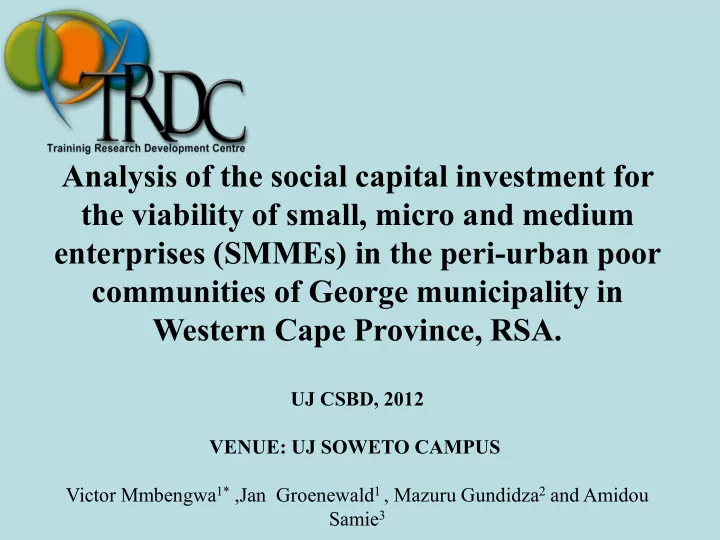

Analysis of the social capital investment for the viability of small, micro and medium enterprises (SMMEs) in the peri-urban poor communities of George municipality in Western Cape Province, RSA. UJ CSBD, 2012 VENUE: UJ SOWETO CAMPUS Victor Mmbengwa 1* ,Jan Groenewald 1 , Mazuru Gundidza 2 and Amidou Samie 3
TABLE OF CONTENTS • INTRODUCTION • AIM & OBJECTIVES • MATERIALS AND METHODS • RESULTS AND DISCUSSION • CONCLUSION
INTRODUCTION • The returns on business investment – social capital • Businesses in township have challenges in harnessing social capital • Katungi et al., (2007) found that household homogeneity has influence on social capital development. • What is a social capital?
Mmbengwa V, 2012, define Social capital as an intangible Definition of social capital varies according to exchange of business context and cultural orientation. experience and skills
Durlauf & Fafchamps (2004) found that: Networks and organizations generate personalized trust and enhance information exchange
The aim and objective of the study was to: Investigates the social capital investment by farming SMMEs in poor communities of George Municipality.
MATERIALS AND METHODS • The research used both qualitative and quantitative methods.
RESULTS AND DISCUSSION • DESCRIPTIVE ANALYSIS • FACTORIAL ANALYSIS • INFERENTIAL ANALYSIS
RESULTS AND DISCUSSION • DESCRIPTIVE ANALYSIS
*=Significant , ns= non significant GENDER MALE FEMALE AGE DESCRIPTIVE VARIABLES Mean 49.45 43.49 Median 50.00 45.00 N 67.00 59.00 Minimum 28.00 26.00 Maximum 70.00 62.00 Standard Deviation 9.23 10.32 Variance 85.22 106.56 Lower conf. interval (95%) 47.20 40.80 Upper conf. Interval (95%) 40.80 46.18 Range 42.00 56.00 Skeweness -0.098 -0.68 Kurtosis -0.57 1.53 Lower quartile (Q25) 43.00 37.00 Upper quartile (Q75) 57.00 52.00 P-Values (95%) 1.00 ns 0.05 *
RESULTS AND DISCUSSION • FACTORIAL ANALYSIS
Factorial analysis of the dependent variables Factor loadings (Unrotated). Extraction: Principal axis factors Variable Factor 1 Rank on loading Study group 0.6305 6 Organised training 0.6465 5 Farm magazine readership 0.6726 3 Networking with experts 0.6793 2 Involvement of relatives in farming 0.6664 4 Children who passed tertiary agric education 0.5071 7 Membership of association 0.7687 1 Expl. Var 3.8015 Prp.Totl 0.4224
RESULTS AND DISCUSSION • INFERENTIAL ANALYSIS
Kruskal-Wallis one-way ANOVA for assessing the attendance of farming study groups Multiple Comparisons p values (2-tailed); Catergorise Kruskal-Wallis test: H ( 2, N= 126) =2.955971 p =.228 Depend.: 1 2 3 Catergorised Age R:71.160 R:61.444 R:69.500 35 yrs and less 0.703752 1.000000 36 to 60yrs 0.703752 1.000000 61 and more 1.000000 1.000000 Keys: 1=attend, 2=attend irregularly and do not attend
Kruskal-Wallis one-way ANOVA for assessing the attendance of farming of training organized by government department Multiple Comparisons p values (2-tailed); Catergor Kruskal-Wallis test: H ( 2, N= 126) =.5905830 p =.7 Depend.: 1 2 3 Catergorised Age R:69.500 R:62.983 R:69.500 Age 35 yrs and less 1.000000 1.0000 Age 36 to 60 yrs 1.000000 1.0000 Age 61 yrs and more 1.000000 1.000000 Keys: 1=attend, 2=attend irregularly and do not attend
Kruskal-Wallis one-way ANOVA for assessing the farmers who reads farmers magazines Multiple Com parisons p values (2-tailed); Catergorised Ag Kruskal-Wallis test: H ( 2, N= 126) =.4644585 p =.7928 Depend.: 1 2 3 Catergorised Age R:69.500 R:63.093 R:69.500 Age 35yrs and less 1.000000 1.000000 Age 36 to 60yrs 1.000000 1.000000 Age 61 yrs and more 1.000000 1.000000
Kruskal-Wallis one-way ANOVA for assessing the networking with professional experts Multiple Comparisons p values (2-tailed); Catergorised Ag Kruskal-Wallis test: H ( 2, N= 126) =.4644585 p =.7928 Depend.: 1 2 3 Catergorised Age R:69.500 R:63.093 R:69.500 Age 35yrs and less 1.000000 1.000000 Age 36 to 60yrs 1.000000 1.000000 Age 61 yrs and more 1.000000 1.000000
Kruskal-Wallis one-way ANOVA for assessing the involvement of relatives in farming Multiple Comparisons p values (2-tailed); Catergorised Ag Kruskal-Wallis test: H ( 2, N= 126) =5.233401 p =.0730 Depend.: 1 2 3 Catergorised Age R:84.786 R:62.124 R:69.500 Age 35 yrs and less 0.332216 1.000000 Age 36 to 60 yrs 0.332216 1.000000 Age 61 yrs and more 1.000000 1.000000
Kruskal-Wallis one-way ANOVA for assessing the children who have studied agriculture at tertiary level Multiple Comparisons p values (2-tailed); Catergorised Age Kruskal-Wallis test: H ( 2, N= 126) =2.279499 p =.3199 Depend.: 1 2 3 Catergorised Age R:71.941 R:62.047 R:69.500 Age 35 yrs and less 0.898133 1.000000 Age 36 to 60 yrs 0.898133 1.000000 Age 61 yrs and more 1.000000 1.000000
Kruskal-Wallis one-way ANOVA for assessing the membership to associations Multiple Comparisons p values (2-tailed); Catergorised Age Kruskal-Wallis test: H ( 2, N= 126) =4.970000 p =.0833 Depend.: 1 2 3 Catergorised Age R:73.540 R:60.843 R:69.500 Age 35yrs and less 0.361026 1.000000 Age 36 to 60yrs 0.361026 1.000000 Age 61 yrs and more 1.000000 1.000000
CONCLUSSION • Lack of social capital investment from youth evident • Awareness of the importance of social capital investment to youth is important. • Experience appears to correlate positively to social capital investment. • Therefore, youth development aimed at social capital development will be inevitable for the viability and sustenance of the farming SMMEs in George
THANK YOU!!!
Recommend
More recommend